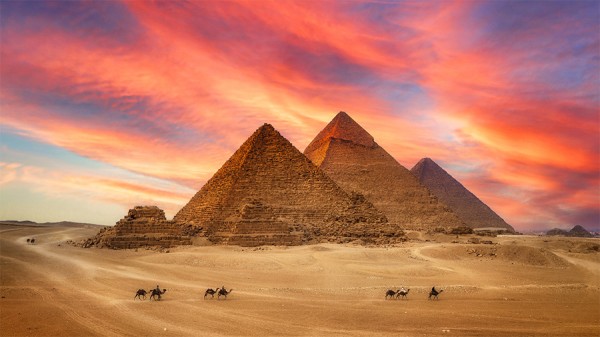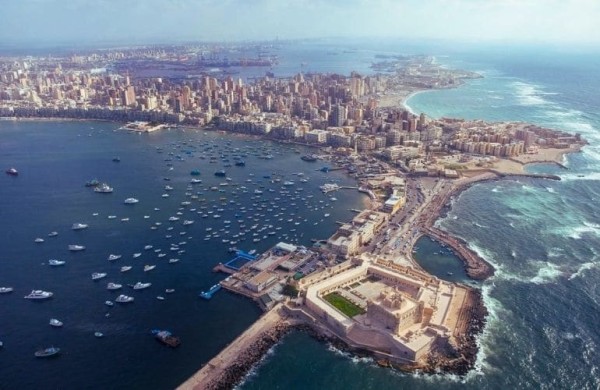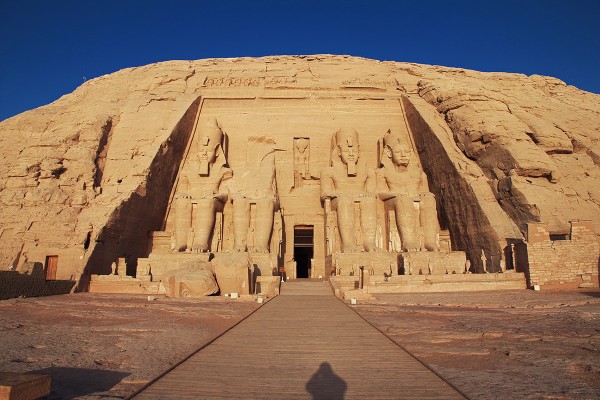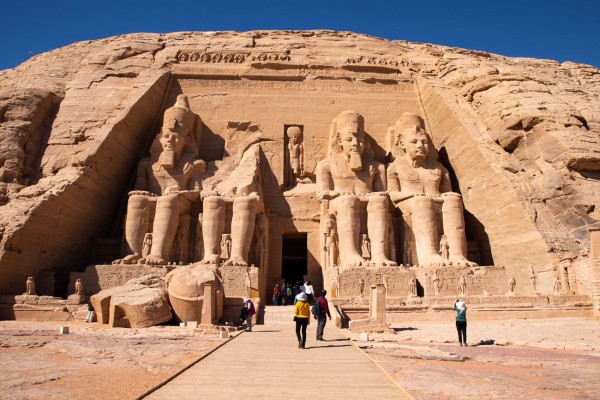Treasure of Egypt
Duration
8 Days
Tour Type
Classical Packages
Location
Egypt
Destinations
Travel Style
Overview
Experience the splendor of Egypt in Cairo, Fayoum, Minya, Abydos, Dandara, and Luxor which includes stops at the Pyramids of Giza, the Sphinx, the Egyptian Museum, Khan El-Khalili, Wadi El-Rayan, Wadi Hitan, Mudawara Mountain, Lake Qaroun, Tuna El-Gabal, Beni Hasan, Tell Al-Amarna, Al-Muharraq Monastery, Seti The First, Dandara Temple, Valley of the Kings & Queens, Luxor Temple, and Karnak Temple.
03 Night's Cairo - 02 Night's Minya - 01 Night Abydos - 01 Night Luxor
Included
Excluded
Itinerary
Welcome to Egypt! Upon arrival Your tour begins when you are greeted by our representative Executive Travel who will assist you through immigration and customs formalities. After you have collected your luggage he will then take you, in our deluxe vehicle, to your Cairo hotel and overnight. Optional Dinner cruise on board river Nile in Cairo
After breakfast, you will meet your Egyptologist guide in the hotel lobby. Begin by exploring the desert antiquities dating back to the beginning of a civilization that arose over 5,000 years ago. You will venture through the desert to visit some of Egypt's oldest sites. First, go to the Pyramids of Giza. Nothing evokes the long and intriguing history of Egypt as powerfully as the pyramids. Rising from the desert, Khufu (Cheops), Khafra and Menkaura symbolize the enigmatic tug of Egypt in our imaginations. The Great Pyramid of Cheops immortalizes the son of Sneferu and Hetephres. Though little is known about this pharaoh, his pyramid is the largest of the three and is comprised of 2.3 million stone blocks, each weighing an average of 2.5 tons., the colossal statue of the Great Sphinx, which as stood guard over the pyramids for millennia. Carved from an outcrop of rock, the Sphinx remains the ultimate symbol of Ancient Egypt with its lion's body and human head. Then continue your introduction to Cairo at the famous Egyptian Museum of Antiquities. The museum houses the greatest collection of Egyptian royal treasures in the world. Your expert guide will take you through the highlights, including the famous Tutankhamun Collection of golden treasures, you will then visit the most famous Bazaar in the middle east Khan El Khalili Bazaar. Then you will be back at your hotel and overnight Meals: Breakfast & Lunch.
After breakfast you will have an early departure to be driven from Cairo to Fayoum, 60 km approx. (02 hours) from Cairo. You will visit Lake Qaroun and then proceed to the National Park of Wadi Rayan where we visit the Water Falls, Gabal Al Modawara and the Wales Cemetery. Enjoy a picnic Lunch. Later, you will head to El Minya and upon arrival, then you will be transferred to your hotel for check-in and overnight. Meals: Breakfast, Lunch & Dinner.
After breakfast you will visit the necropolis of Tuna El Gabal, which includes many important elements such as the crypts of baboons and Ibis that actually represent the god Thoth, the tomb of Isadora, the tomb of the priest Pet-osiers, the old water wheel and the boundary stele of the city of the Aton. Proceed to Al Ashmunien, the ancient city of Hermopolis, where you will visit the open museum with the two colossal baboon statues and the ruins of the basilica church with its Rose granite columns. then, proceed to the site of Beni Hasan, eastern bank of the Nile. There you will visit the unique rock-cut tombs with its scenes depicting local and regional life during the Middle Kingdom. Many of these have scenes of wrestling and military training, then you will back to your hotel and overnight. Meals: Breakfast & Dinner.
After breakfast, you will be driven to Tell Al Amarna approx. (05 hours), the capital of Akhnaton, where you will explore the city, the northern and the southern tombs, the ruins of the palace and temples and finally the royal tomb. Then, you will go to Assuit city to visit Al Muharraq Monastery, 48 kilometers north of Assiut. The Holy Family stayed there for 6 months and 10 days, the longest period spent at any single site, and then you will head to Meir Village which was the functioning cemetery for Cusae, located in Egypt, approximately thirty to forty miles north of the city of Assuit. Meir functioned as an Old Kingdom-Middle Kingdom (6th-12th Dynasty) cemetery for the nomarchs of the fourteenth Nome of Upper Egypt. Below the hillside of the rock-cut tombs lies a cemetery that is specifically for the more common folk. The rock-cut tombs only functioned for nomarchs of the city of Cusae, which was a cult center for the Egyptian deity Hathor. Last, you will be driven to Abydos, then you will be transferred to your hotel for check-in and overnight. Meals: Breakfast & Dinner.
After breakfast you will visit Fortress Shonet El Zebeeb, the first building in the history, then you visit the temple of Seti the first. It is considered the most beautiful temple in Egypt. The temple was built by Seti I and was finished by his son Ramesses II after his father's death. It contains the best-coloured high Reliefs in Egypt and Abydos King List, showing the cartouche name of many dynastic pharaohs of Egypt from the first, Narmer or Menes, until Ramses himself. Then, after enjoy a lovely lunch, you will be driven to the complex of Dandara temple where you will visit Hatour Temple, the goddess of love, music, and dancing. You will have the chance to explore the Temple Elements, the decorated ceiling with its beautiful colored astronomical drawings, the replica of the Egyptian Zodiac, and the crypts. After your visit, you will travel to Luxor by car approx. (02 hours) then you will be transferred to your hotel for check-in and overnight. Meals: Breakfast, Lunch & Dinner.
After breakfast starts visiting the legendary Valley of the Kings that encompasses the East Valley, home to the tombs of the New Kingdom Pharaohs, and the West Valley, which has only one tomb open to the public - the tomb of Ay, who succeeded Tutankhamun to the Egyptian throne. The temple of Queen Hatshepsut of Dynasty XVIII was built just north of the Middle Kingdom temple of Mentuhotep Nebhepetre in the bay of cliffs known as Deir el-Bahri. In ancient times the temple was called Djeser-djeseru, meaning the ’sacred of sacreds’. It was undoubtedly influenced by the style of the earlier temple at Deir el-Bahri, which Hatshepsut chose as the site her temple in a valley sacred to the Theban Goddess of the West. More importantly, it was on a direct axis with Karnak Temple. Two huge ruined statues, the Colossi of Memnon, are around 17 meters/56 feet tall and once stood at the entrance gate of the mortuary temple of Amenhotep III, though very little of the temple behind them remains today. They were cut from two massive granite blocks, brought from quarries near Cairo, and carved to represent the pharaoh Amenhotep III of Dynasty XVIII. The Valley of the Queens is near the better-known Valley of the Kings, on the west bank of the Nile across from Thebes (modern Luxor). This barren area in the western hills was chosen due to its relative isolation and proximity to the capital. The pharaohs of the 18th Dynasty chose to be buried in rock-cut tombs instead of the traditional building of pyramids as burial chambers (perhaps because of their vulnerability to tomb robbers) then continue visiting the East bank (Karnak temple -Luxor temple) then you will be transferred to Luxor airport for your flight back to Cairo, arrive Cairo check-in in your hotel and overnight. Meals: Breakfast & Lunch.
Today you will be transferred to the airport to take your international flight back home Meals: Breakfast.
FAQs
What Is The Children's Policy?
What Is The Booking Policy?
Tipping?
How To Get Egypt Entry Visa?
What Is The Cancellation Policy?
Extra prices:
- {{total_price_html}}
- {{pay_now_price_html}}








